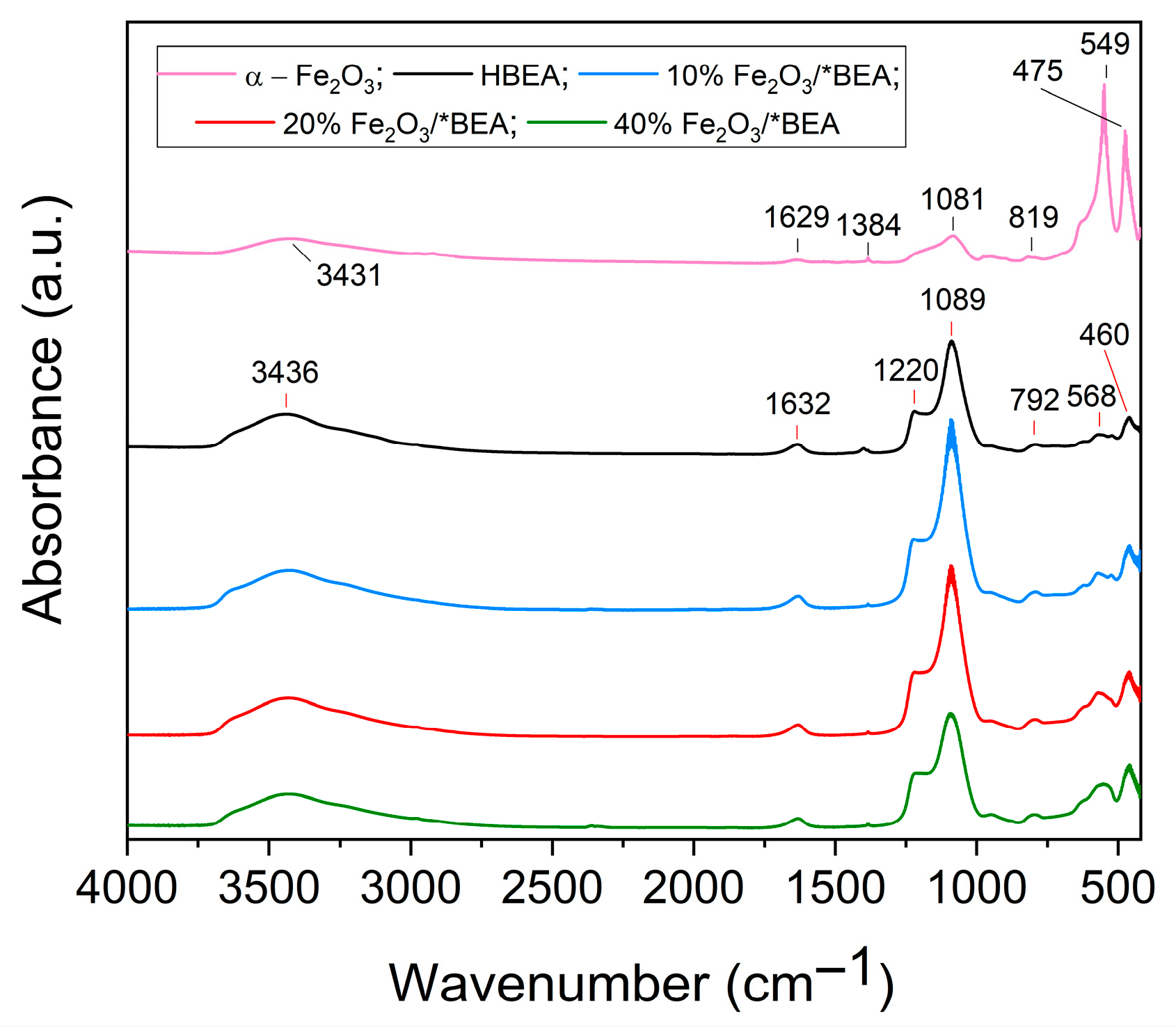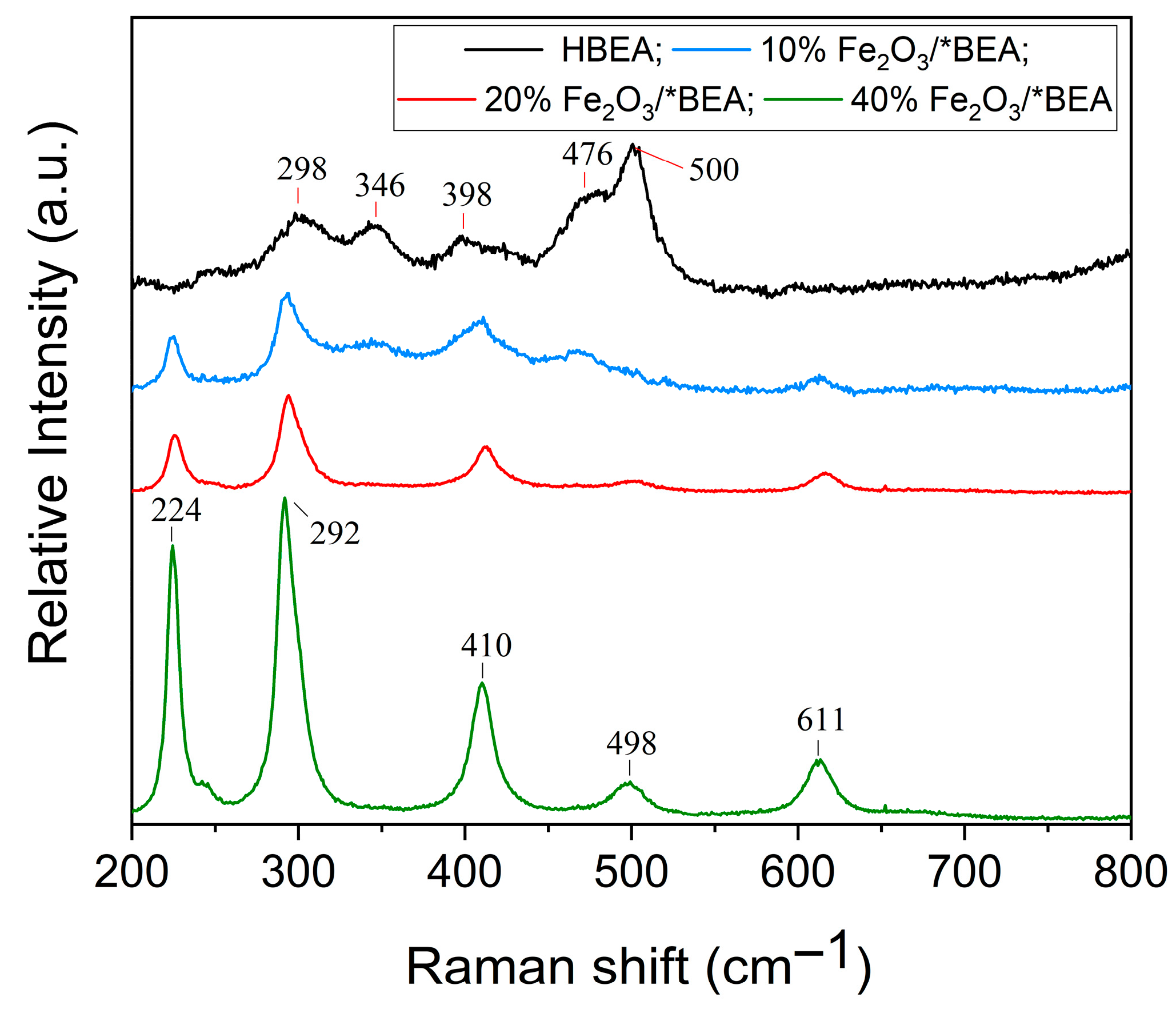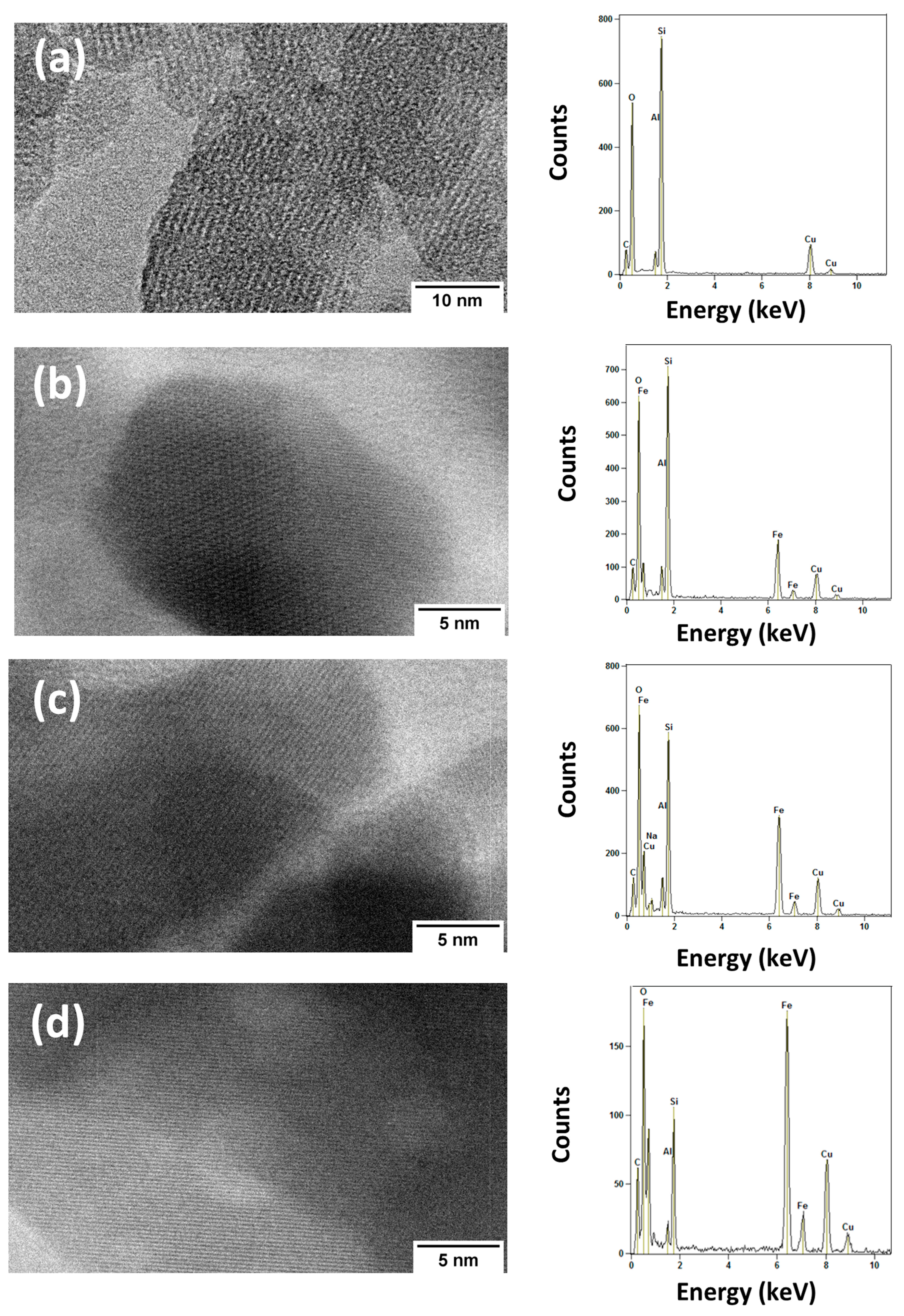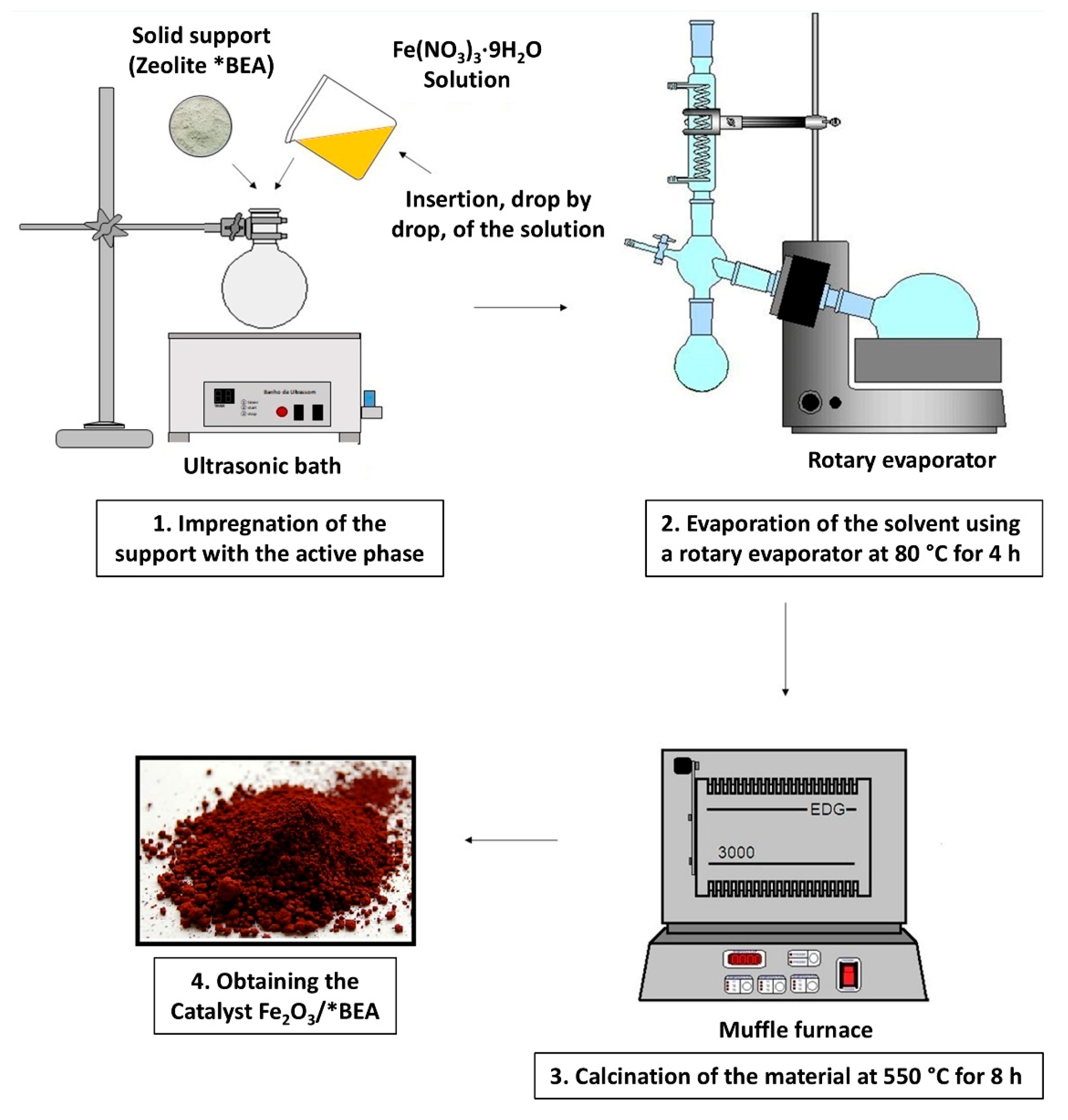Synthesis and Properties of *BEA Zeolite Modified with Iron(III) Oxide
Abstract
1. Introduction
2. Results and Discussion
2.1. Elemental Analysis for Fe2O3 Content
2.2. Powder X-Ray Diffraction (XRD)
2.3. Diffuse Reflectance Spectroscopy (DRS) in the UV-Vis Region
2.4. Infrared Spectroscopy
2.5. Raman Spectroscopy
2.6. Scanning Electron Microscopy Coupled with Energy Dispersive X-Ray (SEM/EDS)
2.7. Transmission Electron Microscopy Coupled with Energy Dispersive X-Ray Spectroscopy (TEM/EDS)
2.8. Textural Properties of the Catalysts
2.9. Acidity of the Catalysts
3. Materials and Methods
3.1. Materials
3.2. Synthesis of the Catalysts
3.3. Catalyst Characterizations
3.3.1. Elemental Analysis of Iron
3.3.2. Powder XRD
3.3.3. Ultraviolet–Visible Diffuse Reflectance Spectroscopy (UV-Vis DRS)
3.3.4. Fourier Transform Infrared Spectroscopy (FT-IR)
3.3.5. Measurements of the Raman Spectra
3.3.6. Scanning Electron Microscopy Coupled with Energy Dispersive X-Ray Spectrometer (SEM/EDS)
3.3.7. Transmission Electron Microscopy Coupled with Energy Dispersive X-Ray Spectrometer (TEM/EDS)
3.3.8. N2 Sorption on the Catalysts
3.3.9. Acidity Measurements of the Catalysts
4. Conclusions
Supplementary Materials
Author Contributions
Funding
Institutional Review Board Statement
Informed Consent Statement
Data Availability Statement
Acknowledgments
Conflicts of Interest
References
- Luque, R.; Burange, A.S. Heterogeneous Catalysis; American Chemical Society: Washington, DC, USA, 2022. [Google Scholar]
- Na, K. Synthesis and Application of Zeolite Catalysts. Catalysts 2021, 11, 685. [Google Scholar] [CrossRef]
- Falcão, E.S.M.; Valadares, D.S.; dos Santos, G.M.; de Mendonça, E.S.D.T.; Santos, M.M.; Dias, S.C.L.; Dias, J.A. Preparation of 12-Tungstophosphoric Acid Embedded in a Silica Matrix and Its Effect on the Activity of 1-Propanol Dehydration. ACS Omega 2025, 10, 16277–16290. [Google Scholar] [CrossRef] [PubMed]
- Sheldon, R.A.; Arends, I.; Hanefeld, U. Green Chemistry and Catalysis; Wiley-VCH Verlag GmbH & Co. KGaA: Weinheim, Germany, 2007. [Google Scholar]
- Yilmaz, B.; Müller, U. Catalytic Applications of Zeolites in Chemical Industry. Top. Catal. 2009, 55, 888–895. [Google Scholar] [CrossRef]
- Khaleque, A.; Alam, M.M.; Hoque, M.; Mondal, S.; Haider, J.B.; Xu, B.; Moni, M.A. Zeolite synthesis from low-cost materials and environmental applications: A review. Environ. Adv. 2020, 2, 100019. [Google Scholar] [CrossRef]
- Hou, X.; Qiu, Y.; Zhang, X.; Liu, G. Analysis of reaction pathways for n-pentane cracking over zeolites to produce light olefins. J. Chem. Eng. 2017, 307, 372–381. [Google Scholar] [CrossRef]
- Sammoury, H.; Toufaily, J.; Cherry, K.; Hamieh, T.; Pouilloux, Y.; Pinard, L. Desilication of *BEA zeolites using different alkaline media: Impact on catalytic cracking of n-hexane. Microporous Mesoporous Mater. 2018, 267, 150–163. [Google Scholar] [CrossRef]
- Bjørgen, M.; Joensen, F.; Holm, M.S.; Olsbye, U.; Lillerud, K.P.; Svelle, S. Methanol to gasoline over zeolite H-ZSM-5: Improved catalyst performance by treatment with NaOH. Appl. Catal. A Gen. 2008, 345, 43–50. [Google Scholar] [CrossRef]
- Guisnet, M.; Ribeiro, F.R. Zeólitos: Um Nanomundo ao Serviço da Catálise; Fundação Calouste Gulbenkian: Lisboa, Portugal, 2004. [Google Scholar]
- Sebakhy, K.O.; Vitale, G.; Pereira-Almao, P. Production of Highly Dispersed Ni within Nickel Silicate Materials with the MFI Structure for the Selective Hydrogenation of Olefins. Ind. Eng. Chem. Res. 2019, 58, 8597–8611. [Google Scholar] [CrossRef]
- Jia, N.; Han, H.; Yang, T.; Zhang, M.; Liu, Z. Synthesis of Dimethyl Terephthalate from Terephthalic Acid Esterification over the Zeolite Catalysts. Inorganics 2025, 13, 184. [Google Scholar] [CrossRef]
- Bai, R.; Song, Y.; Li, Y.; Yu, J. Creating hierarchical pores in zeolite catalysts. Trends Chem. 2019, 1, 601–611. [Google Scholar] [CrossRef]
- Niwa, M.; Katada, N.; Okumura, K. Characterization and Design of Zeolite Catalysts: Solid Acidity, Shape Selectivity and Loading Properties; Springer: Berlin/Heidelberg, Germany, 2010. [Google Scholar]
- Shangbin, L.; Jinfu, W.; Longja, M.; Tseng-Chang, T.; Ikai, W. On the thermal stability of zeolite beta. J. Catal. 1991, 132, 432–439. [Google Scholar] [CrossRef]
- Jon, H.; Lu, B.; Oumi, Y.; Itabashi, K.; Sano, T. Synthesis and thermal stability of beta zeolite using ammonium fluoride. Microporous Mesoporous Mater. 2006, 89, 88–95. [Google Scholar] [CrossRef]
- Quintero, M.; Perez, M.; Meléndez, H.; Rondon, J.; Imbert, F. Síntesis y caracterización de la zeolita Beta. Av. Quim. 2012, 7, 223–226. Available online: http://www.redalyc.org/articulo.oa?id=93325703010 (accessed on 20 March 2025).
- Sazama, P.; Tabor, E.; Klein, P.; Wichterlova, B.; Sklenak, S.; Mokrzycki, L.; Dedecek, J. Al-rich beta zeolites. Distribution of Al atoms in the framework and related protonic and metal-ion species. J. Catal. 2016, 333, 102–114. [Google Scholar] [CrossRef]
- Corma, A. Inorganic solid acids and their use in acid-catalyzed hydrocarbon reactions. Chem. Rev. 1995, 95, 559–614. [Google Scholar] [CrossRef]
- Martínez-Franco, R.; Paris, C.; Martínez-Armero, M.E.; Martínez, C.; Moliner, M.; Corma, A. High-silica nanocrystalline Beta zeolites: Efficient synthesis and catalytic application. Chem. Sci. 2016, 7, 102–108. [Google Scholar] [CrossRef]
- Pornsetmetakul, P.; Coumans, F.J.; van de Poll, R.C.; Liutkova, A.; Suttipat, D.; Mezari, B.; Hensen, E.J. Post-synthesis metal (Sn, Zr, Hf) modification of BEA zeolite: Combined Lewis and Bronsted acidity for cascade catalysis. Chin. J. Catal. 2023, 55, 200–215. [Google Scholar] [CrossRef]
- Gac, W.; Zawadzki, W.; Słowik, G.; Grudziński, W.; Dzwigaj, S. BEA zeolite supported Ce-promoted nickel catalysts for CO2 methanation. Catal. Today 2024, 437, 114728. [Google Scholar] [CrossRef]
- Zheng, X.; Jiao, Y.; Chai, F.; Qu, F.; Umar, A.; Wu, X. Template-free growth of well-crystalline α-Fe2O3 nanopeanuts with enhanced visible-light driven photocatalytic properties. J. Colloid Interface Sci. 2015, 457, 345–352. [Google Scholar] [CrossRef]
- Yang, X.; Cheng, X.; Elzatahry, A.A.; Chen, J.; Alghamdi, A.; Deng, Y. Recyclable Fenton-like catalyst based on zeolite Y supported ultrafine, highly-dispersed Fe2O3 nanoparticles for removal of organics under mild conditions. Chin. Chem. Lett. 2019, 30, 324–330. [Google Scholar] [CrossRef]
- Liu, N.; Zhang, R.; Chen, B.; Li, Y.; Li, Y. Comparative study on the direct decomposition of nitrous oxide over M (Fe, Co, Cu)–BEA zeolites. J. Catal. 2012, 294, 99–112. [Google Scholar] [CrossRef]
- Ogura, M.; Itabashi, K.; Dedecek, J.; Onkawa, T.; Shimada, Y.; Kawakami, K.; Okubo, T. Stabilization of bare divalent Fe(II) cations in Al-rich beta zeolites for superior NO adsorption. J. Catal. 2014, 315, 1–5. [Google Scholar] [CrossRef]
- Martín, N.; Vennestrøm, P.N.; Thøgersen, J.R.; Moliner, M.; Corma, A. Fe-Containing Zeolites for NH3-SCR of NOx: Effect of Structure, Synthesis Procedure, and Chemical Composition on Catalytic Performance and Stability. Chem.—A Eur. J. 2017, 23, 13404–13414. [Google Scholar] [CrossRef]
- Campisi, S.; Palliggiano, S.; Gervasini, A.; Evangelisti, C. Finely iron-dispersed particles on β zeolite from solvated iron atoms: Promising catalysts for NH3-SCO. J. Phys. Chem. C 2019, 123, 11723–11733. [Google Scholar] [CrossRef]
- Liu, B.; Chen, Z.; Huang, J.; Xia, Q.; Wu, Y.; Chen, H.; Fang, Y. Development of iron encapsulated hollow beta zeolites for ammonia selective catalytic reduction. Ind. Eng. Chem. Res. 2019, 58, 2914–2923. [Google Scholar] [CrossRef]
- Cornell, R.M.; Schwertmann, U. The Iron Oxides—Structure, Properties, Reactions, Occurences and Uses, 2nd ed.; Wiley-VCH Verlag GmbH & Co. KGaA: Weinheim, Germany, 2003. [Google Scholar]
- Li, Y.; Shen, W. Morphology-dependent nanocatalysts: Rod-shaped oxides. Chem. Soc. Rev. 2014, 43, 1543–1574. [Google Scholar] [CrossRef]
- Greenwood, N.N.; Earnshaw, A. Chemistry of the Elements; Pergamon Press: Oxford, UK, 1994. [Google Scholar]
- Oliveira, L.C.; Fabris, J.D.; Pereira, M.C. Óxidos de ferro e suas aplicações em processos catalíticos: Uma revisão. Qui. Nova 2013, 36, 123–130. [Google Scholar] [CrossRef]
- Pariente, J.P.; Sánchez-Sánchez, M. (Eds.) Structure and Reactivity of Metals in Zeolite Materials; Springer International Publishing: Cham, Switzerland, 2018. [Google Scholar] [CrossRef]
- Longati, A.A.; Ferreira, W.C.; Quintão, C.M.F.; Maloncy, M.L.; Batista, M.S. Conversão Química de NO e CO sobre Catalisadores à Base de Óxidos de Cobalto ou de Ferro. Qui. Nova 2014, 37, 221–225. [Google Scholar] [CrossRef]
- Pinna, F. Supported metal catalysts preparation. Catal. Today 1998, 41, 129–137. [Google Scholar] [CrossRef]
- Sazama, P.; Sathu, N.K.; Tabor, E.; Wichterlová, B.; Sklenák, Š.; Sobalík, Z. Structure and critical function of Fe and acid sites in Fe-ZSM-5 in propane oxidative dehydrogenation with N2O and N2O decomposition. J. Catal. 2013, 299, 188–203. [Google Scholar] [CrossRef]
- Starokon, E.V.; Parfenov, M.V.; Arzumanov, S.S.; Pirutko, L.V.; Stepanov, A.G.; Panov, G.I. Oxidation of methane to methanol on the surface of FeZSM-5 zeolite. J. Catal. 2013, 300, 47–54. [Google Scholar] [CrossRef]
- Pérez-Ramírez, J.; Groen, J.C.; Brückner, A.; Kumar, M.S.; Bentrup, U.; Debbagh, M.N.; Villaescusa, L.A. Evolution of isomorphously substituted iron zeolites during activation: Comparison of Fe-beta and Fe-ZSM-5. J. Catal. 2005, 232, 318–334. [Google Scholar] [CrossRef]
- Jíša, K.; Nováková, J.; Schwarze, M.; Vondrová, A.; Sklenák, S.; Sobalik, Z. Role of the Fe-zeolite structure and iron state in the N2O decomposition: Comparison of Fe-FER, Fe-BEA, and Fe-MFI catalysts. J. Catal. 2009, 262, 27–34. [Google Scholar] [CrossRef]
- Ma, L.; Chang, H.; Yang, S.; Chen, L.; Fu, L.; Li, J. Relations between iron sites and performance of Fe/HBEA catalysts prepared by two different methods for NH3-SCR. Chem. Eng. J. 2012, 209, 652–660. [Google Scholar] [CrossRef]
- Ma, L.; Li, J.; Arandiyan, H.; Shi, W.; Liu, C.; Fu, L. Influence of calcination temperature on Fe/HBEA catalyst for the selective catalytic reduction of NOx with NH3. Catal. Today 2012, 184, 145–152. [Google Scholar] [CrossRef]
- Xiao, P.; Wang, Y.; Nishitoba, T.; Kondo, J.N.; Yokoi, T. Selective oxidation of methane to methanol with H2O2 over an Fe-MFI zeolite catalyst using sulfolane solvent. Chem. Commun. 2019, 55, 2896–2899. [Google Scholar] [CrossRef]
- Jaafar, N.F.; Jalil, A.A.; Triwahyono, S.; Muhid, M.N.M.; Sapawe, N.; Satar, M.A.H.; Asaari, H. Photodecolorization of methyl orange over α-Fe2O3-supported HY catalysts: The effects of catalyst preparation and dealumination. Chem. Eng. J. 2012, 191, 112–122. [Google Scholar] [CrossRef]
- Oliveira, J.S.D.; Mazutti, M.A.; Urquieta-González, E.A.; Foletto, E.L.; Jahn, S.L. Preparation of mesoporous Fe2O3-supported ZSM-5 zeolites by carbon-templating and their evaluation as photo-Fenton catalysts to degrade organic pollutant. Mat. Res. 2016, 19, 1399–1406. [Google Scholar] [CrossRef]
- Rao, W.; You, C.; Jiang, Y.; Guo, X.; Li, D.; Xu, X.; Lin, K. Iron-doped hierarchically porous Fe-ZSM-5 zeolite with 3D continuous pore architecture for catalytical degradations. Mater. Chem. Phys. 2021, 271, 124704. [Google Scholar] [CrossRef]
- Russo, A.V.; Merlo, B.G.; Jacobo, S.E. Adsorption and catalytic degradation of Tartrazine in aqueous medium by a Fe-modified zeolite. Clean. Eng. Technol. 2021, 4, 100211. [Google Scholar] [CrossRef]
- Chorkendorff, I.; Niemantsverdriet, J.W. Concepts of Modern Catalysis and Kinetics; Wiley-VCH Verlag GmbH & Co. KGaA: Weinheim, Germany, 2003. [Google Scholar]
- Liu, X.; Mäki-Arvela, P.; Aho, A.; Vajglova, Z.; Gun’ko, V.M.; Heinmaa, I.; Murzin, D.Y. Zeta potential of beta zeolites: Influence of structure, acidity, pH, temperature and concentration. Molecules 2018, 23, 946. [Google Scholar] [CrossRef] [PubMed]
- Tavolaro, P.; Tavolaro, A.; Martino, G. Influence of zeolite PZC and pH on the immobilization of cytochrome c: A preliminary study regarding the preparation of new biomaterials. Colloids Surf. B 2009, 70, 98–107. [Google Scholar] [CrossRef]
- Moulijn, J.A.; van Leeuwen, P.W.; van Santen, R.A. (Eds.) Catalysis: An Integrated Approach to Homogeneous, Heterogeneous and Industrial Catalysis; Elsevier: Amsterdam, The Netherlands, 1993; Volume 79. [Google Scholar]
- Freitas, E.F.; Araujo, A.A.; Paiva, M.F.; Dias, S.C.L.; Dias, J.A. Comparative acidity of BEA and Y zeolite composites with 12-tungstophosphoric and 12-tungstosilicic acids. Mol. Catal. 2018, 458, 152–160. [Google Scholar] [CrossRef]
- Najjar, S.; Talaga, D.; Coffinier, Y.; Szunerits, S.; Boukherroub, R.; Servant, L.; Bonhommeau, S. Characterization of single transition metal oxide nanorods by combining atomic force microscopy and polarized micro-Raman spectroscopy. Chem. Phys. Lett. 2011, 514, 128–133. [Google Scholar] [CrossRef]
- Boroń, P.; Chmielarz, L.; Gurgul, J.; Łątka, K.; Gil, B.; Krafft, J.M.; Dzwigaj, S. The influence of the preparation procedures on the catalytic activity of Fe-BEA zeolites in SCR of NO with ammonia and N2O decomposition. Catal. Today 2014, 235, 210–225. [Google Scholar] [CrossRef]
- Silaghi, M.C.; Chizallet, C.; Raybaud, P. Challenges on molecular aspects of dealumination and desilication of zeolites. Microporous Mesoporous Mater. 2014, 191, 82–96. [Google Scholar] [CrossRef]
- Sayed, F.N.; Polshettiwar, V. Facile and sustainable synthesis of shaped iron oxide nanoparticles: Effect of iron precursor salts on the shapes of iron oxides. Sci. Rep. 2015, 5, 9733. [Google Scholar] [CrossRef]
- Kou, Y.; Luo, P.; Xiao, L.; Xin, Y.; Zhang, G.; Hu, Y.; Hao, G. The positive correlation between the dispersion and catalytic performance of Fe2O3 nanoparticles in nano-Fe2O3–ultrafine AP energetic composites supported by solid UV-vis spectroscopy. Dalton Trans. 2023, 52, 12796–12807. [Google Scholar] [CrossRef]
- Parhizkar, J.; Habibi, M.H. Synthesis, characterization and photocatalytic properties of Iron oxide nanoparticles synthesized by sol-gel autocombustion with ultrasonic irradiation. Nanochem. Res. 2017, 2, 166–171. [Google Scholar] [CrossRef]
- Neamţu, M.; Catrinescu, C.; Kettrup, A. Effect of dealumination of iron(III) –exchanged Y zeolites on oxidation of Reactive Yellow 84 azo dye in the presence of hydrogen peroxide. Appl. Catal. B 2004, 51, 149–157. [Google Scholar] [CrossRef]
- Rache, M.L.; García, A.R.; Zea, H.R.; Silva, A.M.; Madeira, L.M.; Ramírez, J.H. Azo-dye orange II degradation by the heterogeneous Fenton-like process using a zeolite Y-Fe catalyst—Kinetics with a model based on the Fermi’s equation. Appl. Catal. B 2014, 146, 192–200. [Google Scholar] [CrossRef]
- Campos, E.A.; Pinto, D.V.B.S.; Oliveira, J.I.S.D.; Mattos, E.D.C.; Dutra, R.D.C.L. Synthesis, characterization and applications of iron oxide nanoparticles-a short review. J. Aerosp. Technol. Manag. 2015, 7, 267–276. [Google Scholar] [CrossRef]
- Dehbi, A.; Dehmani, Y.; Omari, H.; Lammini, A.; Elazhari, K.; Abdallaoui, A. Hematite iron oxide nanoparticles (α-Fe2O3): Synthesis and modelling adsorption of malachite green. J. Environ. Chem. Eng. 2020, 8, 103394. [Google Scholar] [CrossRef]
- Kim, J.; Jentys, A.; Maier, S.M.; Lercher, J.A. Characterization of Fe-exchanged BEA zeolite under NH3 selective catalytic reduction conditions. J. Phys. Chem. C 2013, 117, 986–993. [Google Scholar] [CrossRef]
- De Faria, D.L.; Venâncio Silva, S.; de Oliveira, M.T. Raman microspectroscopy of some iron oxides and oxyhydroxides. J. Raman Spectrosc. 1997, 28, 873–878. [Google Scholar] [CrossRef]
- Jubb, A.M.; Allen, H.C. Vibrational spectroscopic characterization of hematite, maghemite, and magnetite thin films produced by vapor deposition. ACS Appl. Mater. Interfaces 2010, 2, 2804–2812. [Google Scholar] [CrossRef]
- Mihailova, B.; Valtchev, V.; Mintova, S.; Faust, A.C.; Petkov, N.; Bein, T. Interlayer stacking disorder in zeolite beta family: A Raman spectroscopic study. Phys. Chem. Chem. Phys. 2005, 7, 2756–2763. [Google Scholar] [CrossRef] [PubMed]
- Bárcia, P.S.; Silva, J.A.; Rodrigues, A.E. Adsorption equilibrium and kinetics of branched hexane isomers in pellets of BETA zeolite. Microporous Mesoporous Mater. 2005, 79, 145–163. [Google Scholar] [CrossRef]
- Bandala, E.R.; Sadek, R.; Gurgul, J.; Łątka, K.; Zimowska, M.; Valentin, L.; Dzwigaj, S. Assessment of the capability of Fe and Al modified BEA zeolites to promote advanced oxidation processes in aqueous phase. Chem. Engin. J. 2021, 409, 127379. [Google Scholar] [CrossRef]
- Zhang, H.; Xie, B.; Meng, X.; Müller, U.; Yilmaz, B.; Feyen, M.; Xiao, F.S. Rational synthesis of Beta zeolite with improved quality by decreasing crystallization temperature in organotemplate-free route. Microporous Mesoporous Mater. 2013, 180, 123–129. [Google Scholar] [CrossRef]
- Tadic, M.; Kopanja, L.; Panjan, M.; Lazovic, J.; Tadic, B.V.; Stanojevic, B.; Motte, L. Rhombohedron and plate-like hematite (α-Fe2O3) nanoparticles: Synthesis, structure, morphology, magnetic properties and potential biomedical applications for MRI. Mater. Res. Bull. 2021, 133, 111055. [Google Scholar] [CrossRef]
- da Silva, C.P.; da Guarda Souza, M.O.; Huaman, N.R.C.; Neves, I.R.; Brandão, S.T. Rapid and sustainable synthesis of iron (III) oxide nanoparticles with photocatalytic properties using microwave heating. Appl. Catal. A Gen. 2025, 708, 120551. [Google Scholar] [CrossRef]
- Aslam, M.; Qamar, M.T.; Rehman, A.U.; Soomro, M.T.; Ali, S.; Ismail, I.M.I.; Hameed, A. The evaluation of the photocatalytic activity of magnetic and non-magnetic polymorphs of Fe2O3 in natural sunlight exposure: A comparison of photocatalytic activity. Appl. Surf. Sci. 2018, 451, 128–140. [Google Scholar] [CrossRef]
- Petushkov, A.; Merilis, G.; Larsen, S.C. From nanoparticles to hierarchical structures: Controlling the morphology of zeolite beta. Microporous Mesoporous Mater. 2011, 143, 97–103. [Google Scholar] [CrossRef]
- Escola, J.M.; Serrano, D.P.; Sanz, R.; Garcia, R.A.; Peral, A.; Moreno, I.; Linares, M.J.C.T. Synthesis of hierarchical Beta zeolite with uniform mesopores: Effect on its catalytic activity for veratrole acylation. Catal. Today 2018, 304, 89–96. [Google Scholar] [CrossRef]
- Thommes, M.; Kaneko, K.; Neimark, A.V.; Olivier, J.P.; Rodriguez-Reinoso, F.; Rouquerol, J.; Sing, K.S.W. Physisorption of Gases, with Special Reference to the Evaluation of Surface Area and Pore Size Distribution (IUPAC Technical Report). Pure Appl. Chem. 2015, 87, 1051–1069. [Google Scholar] [CrossRef]
- da Silva Valadares, D.; de Carvalho, W.H.R.; Fonseca, A.L.F.; Machado, G.d.F.; Silva, M.R.; Campos, P.T.A.; Dias, J.A.; Dias, S.C.L. Different Routes for the Hierarchization of *BEA Zeolite, Followed by Impregnation with Niobium and Application in Ethanol and 1-Propanol Dehydration. Catalysts 2025, 15, 340. [Google Scholar] [CrossRef]
- Valadares, D.S.; Clemente, M.C.H.; de Freitas, E.F.; Martins, G.A.V.; Dias, J.A.; Dias, S.C.L. Niobium on BEA Dealuminated Zeolite for High Selectivity Dehydration Reactions of Ethanol and Xylose into Diethyl Ether and Furfural. Nanomaterials 2020, 10, 1269. [Google Scholar] [CrossRef]
- Drago, R.S.; Dias, S.C.; Torrealba, M.; de Lima, L. Calorimetric and spectroscopic investigation of the acidity of HZSM-5. J. Am. Chem. Soc. 1997, 119, 4444–4452. [Google Scholar] [CrossRef]
- Parry, E.P. An infrared study of pyridine adsorbed on acidic solids. Characterization of surface acidity. J. Catal. 1963, 2, 371–379. [Google Scholar] [CrossRef]
- Valadares, D.d.S.; de França, J.O.C.; Fernandes, R.C.; Dezaneti, L.M.; Loureiro Dias, S.C.; Dias, J.A. Liquid Phase Calorimetric Method as a Tool for Acid Strength Measurements and Application to a Variety of Sustainable Catalysts. Chemistry 2023, 5, 1138–1170. [Google Scholar] [CrossRef]
- de Mendonça, E.S.D.T.; de Faria, A.C.B.; Dias, S.C.L.; Aragón, F.F.; Mantilla, J.C.; Coaquira, J.A.; Dias, J.A. Effects of silica coating on the magnetic properties of magnetite nanoparticles. Surf. Interfaces 2019, 14, 34–43. [Google Scholar] [CrossRef]
- Jeffery, G.H.; Basset, J.; Mendham, J.; Denney, R.C. Textbook of Quantitative Chemical Analysis, 5th ed.; Longman Group: London, UK, 1989. [Google Scholar]
- Breitkreitz, M.C.; Souza, A.M.D.; Poppi, R.J. Experimento didático de quimiometria para planejamento de experimentos: Avaliação das condições experimentais na determinação espectrofotométrica de ferro II com o-fenantrolina. Um tutorial, parte III. Quí. Nova 2014, 37, 564–573. [Google Scholar] [CrossRef]
- Tauc, J.; Grigorovici, R.; Vancu, A. Optical properties and electronic structure of amorphous germanium. Phys. Status Solidi B 1966, 15, 627–637. [Google Scholar] [CrossRef]
- Shimadzu Corporation. Measurements of Band Gap in Compound Semiconductors–Band Gap Determination from Diffuse Reflectance Spectra. Applications News—Spectrophotometric analysis, Nº. A428. Available online: https://www.ssi.shimadzu.com/literature/literature1338.html (accessed on 30 March 2025).
- Baerlocher, C.; McCusker, L.B.; Gies, H.; Marler, B. Database of Disordered Zeolite Structures. Available online: http://www.iza-structure.org/databases/ (accessed on 25 October 2025).
- El Mendili, Y.; Bardeau, J.-F.; Randrianantoandro, N.; Grasset, F.; Greneche, J.-M. Insights into the Mechanism Related to the Phase Transition from α-Fe2O3 to γ-Fe2O3 Nanoparticles Induced by Thermal Treatment and Laser Irradiation. J. Phys. Chem C 2012, 116, 23785–23792. [Google Scholar] [CrossRef]
- Vaitkus, A.; Merkys, A.; Sander, T.; Quirós, M.; Thiessen, P.A.; Bolton, E.E.; Gražulis, S. A workflow for deriving chemical entities from crystallographic data and its application to the Crystallography Open Database. J. Cheminform. 2023, 15, 123. [Google Scholar] [CrossRef]









| Catalyst | Quantity of Fe2O3 (%) |
|---|---|
| 10% Fe2O3/*BEA | 10.5 |
| 20% Fe2O3/*BEA | 17.2 |
| 40% Fe2O3/*BEA | 39.6 |
| Catalyst | Relative Crystallinity (%) | D (nm) | Band Gap (eV) |
|---|---|---|---|
| Fe2O3 | n/a | 42 | n/a |
| HBEA | 100 | 16 | n/a |
| 10% Fe2O3/*BEA | 70 | 19 | 1.98 |
| 20% Fe2O3/*BEA | 85 | 26 | 2.00 |
| 40% Fe2O3/*BEA | 76 | 28 | 2.05 |
| Catalyst | Area (m2/g) | Volume (cm3/g) | |||
|---|---|---|---|---|---|
| SBET a | SMICRO b | SEXT c | Vp d | Vµ e | |
| Fe2O3 | 11 | 0.2 | 11 | 0.07 | 0 |
| HBEA | 705 | 518 | 187 | 0.86 | 0.23 |
| 10% Fe2O3/*BEA | 422 | 300 | 121 | 0.65 | 0.14 |
| 20% Fe2O3/*BEA | 334 | 243 | 91 | 0.47 | 0.11 |
| 40% Fe2O3/*BEA | 377 | 223 | 154 | 0.57 | 0.10 |
| Catalyst | NPy (mmol/g) |
|---|---|
| HBEA | 0.63 |
| 10% Fe2O3/*BEA | 0.65 |
| 20% Fe2O3/*BEA | 0.47 |
| 40% Fe2O3/*BEA | 0.44 |
Disclaimer/Publisher’s Note: The statements, opinions and data contained in all publications are solely those of the individual author(s) and contributor(s) and not of MDPI and/or the editor(s). MDPI and/or the editor(s) disclaim responsibility for any injury to people or property resulting from any ideas, methods, instructions or products referred to in the content. |
© 2025 by the authors. Licensee MDPI, Basel, Switzerland. This article is an open access article distributed under the terms and conditions of the Creative Commons Attribution (CC BY) license (https://creativecommons.org/licenses/by/4.0/).
Share and Cite
dos Santos, G.M.; Paiva, M.F.; de França, J.O.C.; Dias, S.C.L.; Dias, J.A. Synthesis and Properties of *BEA Zeolite Modified with Iron(III) Oxide. Inorganics 2025, 13, 383. https://doi.org/10.3390/inorganics13120383
dos Santos GM, Paiva MF, de França JOC, Dias SCL, Dias JA. Synthesis and Properties of *BEA Zeolite Modified with Iron(III) Oxide. Inorganics. 2025; 13(12):383. https://doi.org/10.3390/inorganics13120383
Chicago/Turabian Styledos Santos, Giovana Magalhães, Mateus Freitas Paiva, Juliene Oliveira Campos de França, Sílvia Cláudia Loureiro Dias, and José Alves Dias. 2025. "Synthesis and Properties of *BEA Zeolite Modified with Iron(III) Oxide" Inorganics 13, no. 12: 383. https://doi.org/10.3390/inorganics13120383
APA Styledos Santos, G. M., Paiva, M. F., de França, J. O. C., Dias, S. C. L., & Dias, J. A. (2025). Synthesis and Properties of *BEA Zeolite Modified with Iron(III) Oxide. Inorganics, 13(12), 383. https://doi.org/10.3390/inorganics13120383







